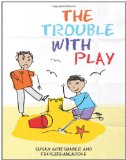Recommended Resources
The Trouble with Play. A Thought Provoking Book
The Trouble with Play by Susan Grieshaber and Felicity McArdle. Open University Press (2010)

This book will challenge any preconceptions about the innocence and universal benefit of play. It is based on naturalistic observations of children, where researchers do not interrupt or disturb the play, so the ‘real’ situation can be witnessed.The result is a number of fascinating, and sometimes disturbing, vignettes of play behaviour.
Some of these were very familiar scenes: the teacher who encourages a child to join in with a group playing Cinderella. But the newcomer is chosen by the other children to play “the piece of paper that was in front of the fireplace, collecting the cinders”.
How often do we encourage our children to “play together” and how often do we say “we’re all friends here” – to then go away convinced that its preferable for children to play socially than by themselves? Only to find the children subverting these good intentions for their own purpose. More importantly, how often do we find out that the children have subverted the play? As the authors assert “The Trouble With Play helps identify and recognise injustice that occurs in play”.
The authors, Susan Grieshaber and Felicity McArdle, challenge play in six areas: play is natural; is about development and learning; is normal; is fun; is innocent and is a universal right. Each of the six areas are considered in detail, brought to life by many vignettes. There are reflection points and practical activities throughout the book are excellent starting points for discussions for students as well as staff meetings and training courses.
The penultimate chapter compares curricula from four different countries – Hong Kong, Australia, Sweden and England. This really made me realise how easy it is to become parochial in our use of curricula. Working in England means that I live and breathe the Early Years Foundation Stage (EYFS). But what are children in other countries experiencing? There are some interesting similarities and significant differences.
In Hong Kong, children aged 5 to 6 would be encouraged to play chess, Australia educators are ‘deliberate, purposeful and thoughtful in their decisions and actions’, the Swedish curriculum is fully integrated to age 20.
My only (very small) disappointment was that the myth that the Early Learning Goals in the EYFS “must” be achieved by the end of the year in which children turn 5 years old. This is not the case – at the minute. But who knows with the results of EYFS review still to be announced? Overall a very interesting, thoughtful book.
As Sir Terry Pratchett observes in ‘The Hogfather’ its “nice to hear the voices of little children at play, provided you took care to be far enough away not to hear what they were actually saying”.
Kathy Brodie
https://www.kathybrodie.comKathy Brodie is an author, Early Years Professional and Trainer specialising in online training and courses. She is the founder and host of the Early Years Summit and Early Years TV, weekly Professional Development for Early Years practitioners and educators.

AUTHOR Cath Arnold
Posted on 7:06 am January 17, 2017.
Sounds like a really interesting read! I’m still a big fan of Susan Isaacs’ observations made in the 1920s. These, too, were naturalistic and, as a teacher, she was open to whatever the children brought to the play (including burying and then digging up the dead rabbit to check whether it was still dead). I do think we rather ‘sanitise’ children’s play in our efforts to ‘socialise’ the children.
AUTHOR Kathy
Posted on 9:41 am January 17, 2017.
Hi Cath,
Many thanks indeed for your comment. Excellent point, thank you – Susan Isaacs observations are very interesting and I don’t think children have changed too much since she was making those observations. We do have to be careful not to put an adult agenda onto children’s play. After all, we would expect adults to socialise in different ways, be fascinated by the macabre etc. so why not children?
Best regards
Kathy
AUTHOR Liz
Posted on 12:19 pm August 4, 2015.
I have found that Sir Terry is frequently a better observer of people and a better trainer of educators than many childcare ‘experts’!!
AUTHOR Jane Evans
Posted on 11:19 am June 5, 2012.
Very thought provoking, am looking forward to reading it. Remember listening in horror in a pre-school to some play that involved a dead baby in a tree. Luckily some one identified it as a scene from an episode of Emmerdale!! Just shows how children use play to process what they have seen and a heard.
AUTHOR Kathy
Posted on 12:04 am June 6, 2012.
Thanks for your comment Jane.
You are absolutely right, you can get a real window into a child’s thinking from their free play. Sometimes it’s best to know the context first though!
AUTHOR Melitsa
Posted on 2:17 pm September 23, 2011.
Thanks for highlighting this book. Adding to my wishlist and pinned 🙂
AUTHOR Kathy
Posted on 3:47 pm September 26, 2011.
I hope you’ll enjoy it as much as I did. There were certainly some scenarios in there which rung true to my own experience!